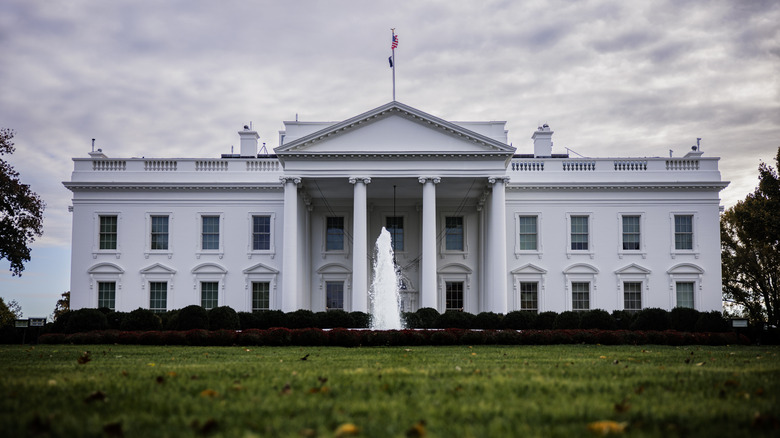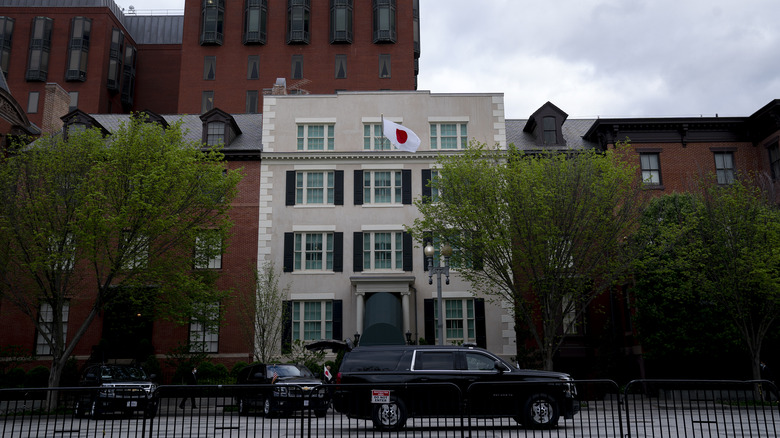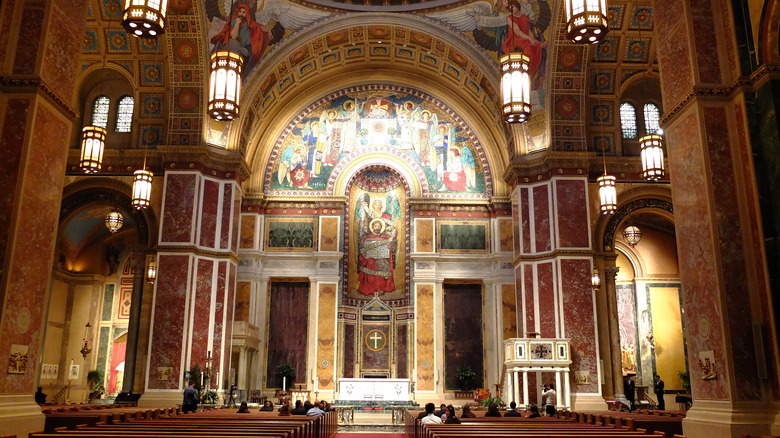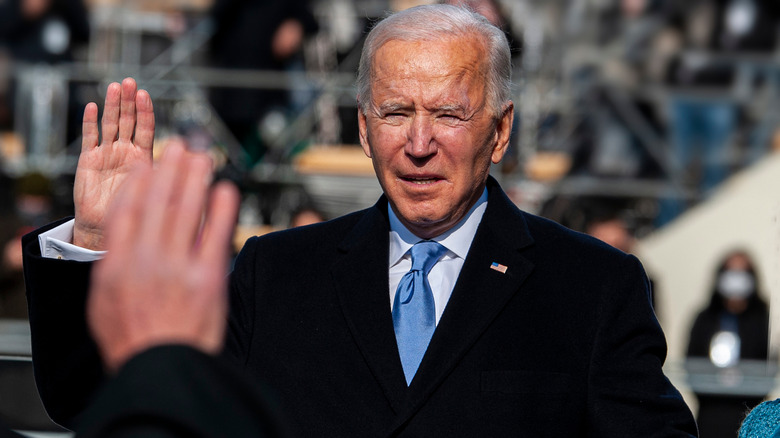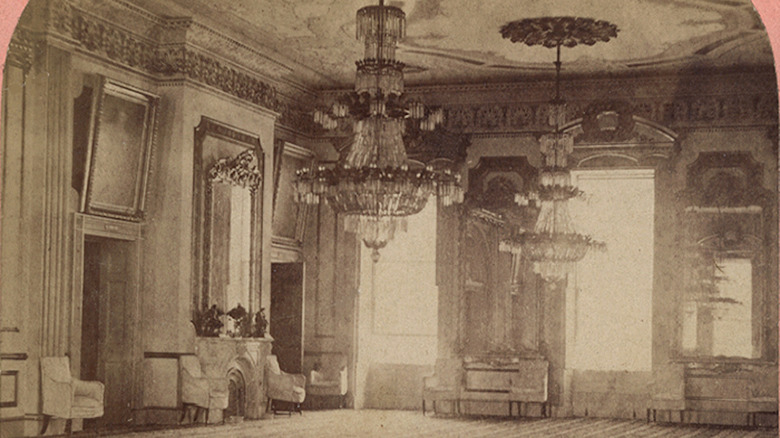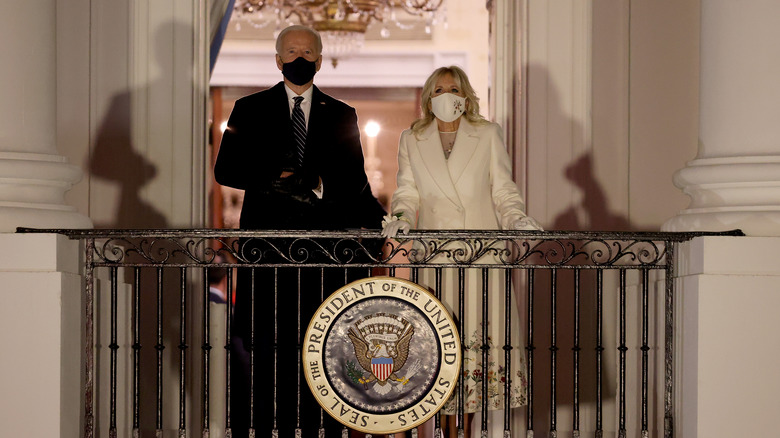How New Presidents Move Into The White House So Quickly
While presidential administrations come and go, much of the staff of the White House is permanent. These long-time workers are called "lifers," and some have served as long as 40 or 50 years. They often have their own opinions about the way things should be done and don't always approve of changes made by the first family or by a new chief usher, the person who leads the whole White House team (via The New Yorker).
They may have good reason: They have the running of the house down to a science, and that includes the process of moving one family out and the next in. Most of the moving process has to be done on Inauguration Day, and more specifically during a five-hour period during the swearing-in and Congressional luncheon, according to The Hill. Doing this requires serious coordination, plenty of preparation, and a team that's all on the same page.
Before the inauguration
Normally, the process of moving a new first family into the White House begins as soon as the new president's opponent concedes the election, according to The Hill. The outgoing first family generally has their things packed by the morning of the inauguration, but some do more in advance than others do. They aren't allowed to keep anything from the White House's permanent collection, but can sometimes keep gifts from visitors to the house.
Meanwhile, the incoming first family relocates to Washington, D.C. and normally stays in the president's guest house, Blair House, at 1651 Pennsylvania Ave. N.W. Prior to the inauguration, they visit the White House's permanent collection at a facility in Maryland so they can select artwork and furniture they want to use. The White House staff receives information about these selections as well as the layout the new family wants to use for various rooms. They also get more detailed info about the family's preferences, such as favorite snacks and ideal room temperature (via The Hill).
Inauguration Day: the morning
Normally, the White House staff starts work on the morning of the inauguration as early as 4 a.m. This gives them time to work on any repairs or changes that take longer than just a couple of hours. At 8:30 a.m., official events begin. The first is the staff's goodbye to the outgoing first family. The staff gives the first family a gift of two flags that flew over the White House while they lived there, presented in a box made of wood from the house, according to The Hill.
Meanwhile, the president-elect attends church, usually at the Episcopal St. John's Church. Joe Biden, a Catholic, chose to go to the Cathedral of St. Matthew the Apostle instead. Members of Congress sometimes join them for the service. The new first family then comes to the White House and is greeted by the outgoing family with a tea party. This didn't happen in 2021. Donald Trump was the first outgoing president since 1869 to choose not to participate in any inaugural events for the incoming president. Instead, the Biden family was welcomed by then-chief usher of the White House Timothy Harleth (via The Hill).
Inauguration Day: the afternoon
Usually at 10:30 a.m., both families leave the White House and travel to the Capitol together. The White House staff then has between four and five hours to move out the outgoing family's belongings and move in the incoming family's. Empty trucks wait outside for anything leaving the house. Anything that belongs to the White House collection goes back to the Maryland storage facility, unlike the outgoing family's personal belongings. As the new family's things are brought in, other changes happen as well: from minor repairs and paint touch-ups to the changing of a room's function (for instance, if the incoming family wants a room changed to serve as a gym for them). State rooms stay mostly the same. The rooms are all cleaned during this time as well (via The Hill).
After the swearing-in and the Congressional luncheon, the new first family comes back to the White House to watch the inaugural parade from a viewing platform. They are also shown into their new living spaces and begin to prepare for the inaugural ball. All this was a little different during the Trump-Biden exchange, too. Because of COVID-19 concerns, the inaugural parade was virtual and the ball was canceled. Social distancing and cleaning regulations also complicated the exchange (via The Hill).
How much can the new first family change?
The incoming first family can, of course, bring personal possessions and some personal furniture with them. They don't have to use the same White House furnishings as the previous family. They can use anything in the White House's permanent collection, which includes around 500 pieces of art, including works by Norman Rockwell and Georgia O'Keeffe. This doesn't include any of the White House's original furnishings, because those were destroyed in the War of 1812 (via Slate).
The family has more say over the look of the rooms on the top two floors, which is their living space. The state rooms on the bottom floor don't change very much from one administration to the next; the family has to have permission from the Committee for Preservation of the White House to make any major changes to these rooms. (The committee was founded in 1964 by Lyndon B. Johnson as part of continuing efforts, started by Jackie Kennedy, to protect the White House, according to the White House Historical Association.) The same is true for historic guest rooms like the Lincoln Bedroom (via Slate).
Some families make bigger changes to the house and grounds. The Kennedys added a swimming pool, and Richard Nixon built a one-lane bowling alley in the White House. Jimmy Carter and George W. Bush added energy-saving features like solar panels and CFL bulbs, according to Slate.
It doesn't always go off without a hitch
There are times when the White House staff has to deal with some last-minute hiccups in the moving process. Sometimes, these are caused by presidential children. Staffers were dismayed to find that Sasha Obama's closet hadn't been cleaned out when the Obamas were leaving in 2017 (via The New Yorker). In 1989, during George H. W. Bush's inaugural parade, his granddaughters Jenna and Barbara decided they wanted to come into the White House, so a staff florist took them to her workshop and gave an unplanned lesson on flower-arranging, according to The Washington Post.
Sometimes, it's the adults who cause a hitch. During his inaugural parade in 1993, Bill Clinton took pity on groups whose floats broke down and invited them — along with a couple thousand or so other people — to visit the White House the next day. The total number of guests was triple what the White House staff had expected, and they didn't have enough hot chocolate to serve (via The Washington Post).
Occasionally, it's even the well-trained staff who trip up. On Biden's inauguration day, the White House doors weren't open for him and Dr. Jill Biden when they arrived. They had to wait for an awkward moment before going in. This may have been because the chief usher had been fired earlier that morning, according to The New Yorker.
